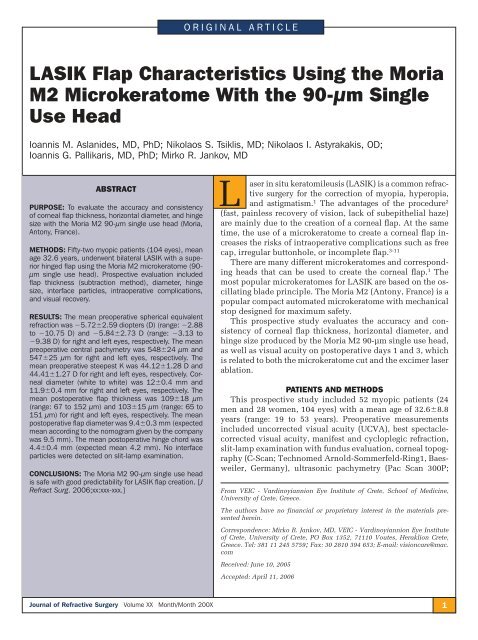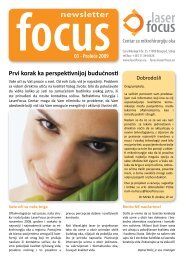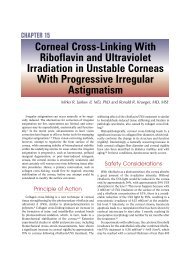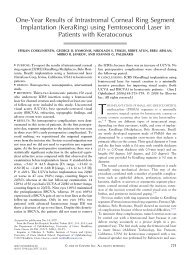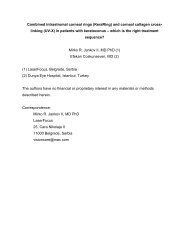LASIK Flap Characteristics Using the Moria M2 ... - LaserFocus
LASIK Flap Characteristics Using the Moria M2 ... - LaserFocus
LASIK Flap Characteristics Using the Moria M2 ... - LaserFocus
You also want an ePaper? Increase the reach of your titles
YUMPU automatically turns print PDFs into web optimized ePapers that Google loves.
ORIGINAL ARTICLE<strong>LASIK</strong> <strong>Flap</strong> <strong>Characteristics</strong> <strong>Using</strong> <strong>the</strong> <strong>Moria</strong><strong>M2</strong> Microkeratome With <strong>the</strong> 90-µm SingleUse HeadIoannis M. Aslanides, MD, PhD; Nikolaos S. Tsiklis, MD; Nikolaos I. Astyrakakis, OD;Ioannis G. Pallikaris, MD, PhD; Mirko R. Jankov, MDABSTRACTPURPOSE: To evaluate <strong>the</strong> accuracy and consistencyof corneal fl ap thickness, horizontal diameter, and hingesize with <strong>the</strong> <strong>Moria</strong> <strong>M2</strong> 90-µm single use head (<strong>Moria</strong>,Antony, France).METHODS: Fifty-two myopic patients (104 eyes), meanage 32.6 years, underwent bilateral <strong>LASIK</strong> with a superiorhinged fl ap using <strong>the</strong> <strong>Moria</strong> <strong>M2</strong> microkeratome (90-µm single use head). Prospective evaluation includedfl ap thickness (subtraction method), diameter, hingesize, interface particles, intraoperative complications,and visual recovery.RESULTS: The mean preoperative spherical equivalentrefraction was 5.722.59 diopters (D) (range: 2.88to 10.75 D) and 5.842.73 D (range: 3.13 to9.38 D) for right and left eyes, respectively. The meanpreoperative central pachymetry was 54824 µm and54725 µm for right and left eyes, respectively. Themean preoperative steepest K was 44.121.28 D and44.411.27 D for right and left eyes, respectively. Cornealdiameter (white to white) was 120.4 mm and11.90.4 mm for right and left eyes, respectively. Themean postoperative fl ap thickness was 10918 µm(range: 67 to 152 µm) and 10315 µm (range: 65 to151 µm) for right and left eyes, respectively. The meanpostoperative fl ap diameter was 9.40.3 mm (expectedmean according to <strong>the</strong> nomogram given by <strong>the</strong> companywas 9.5 mm). The mean postoperative hinge chord was4.40.4 mm (expected mean 4.2 mm). No interfaceparticles were detected on slit-lamp examination.CONCLUSIONS: The <strong>Moria</strong> <strong>M2</strong> 90-µm single use headis safe with good predictability for <strong>LASIK</strong> fl ap creation. [JRefract Surg. 2006;xx:xxx-xxx.]Laser in situ keratomileusis (<strong>LASIK</strong>) is a common refractivesurgery for <strong>the</strong> correction of myopia, hyperopia,and astigmatism. 1 The advantages of <strong>the</strong> procedure 2(fast, painless recovery of vision, lack of subepi<strong>the</strong>lial haze)are mainly due to <strong>the</strong> creation of a corneal flap. At <strong>the</strong> sametime, <strong>the</strong> use of a microkeratome to create a corneal flap increases<strong>the</strong> risks of intraoperative complications such as freecap, irregular buttonhole, or incomplete flap. 3-11There are many different microkeratomes and correspondingheads that can be used to create <strong>the</strong> corneal flap. 1 Themost popular microkeratomes for <strong>LASIK</strong> are based on <strong>the</strong> oscillatingblade principle. The <strong>Moria</strong> <strong>M2</strong> (Antony, France) is apopular compact automated microkeratome with mechanicalstop designed for maximum safety.This prospective study evaluates <strong>the</strong> accuracy and consistencyof corneal flap thickness, horizontal diameter, andhinge size produced by <strong>the</strong> <strong>Moria</strong> <strong>M2</strong> 90-µm single use head,as well as visual acuity on postoperative days 1 and 3, whichis related to both <strong>the</strong> microkeratome cut and <strong>the</strong> excimer laserablation.PATIENTS AND METHODSThis prospective study included 52 myopic patients (24men and 28 women, 104 eyes) with a mean age of 32.68.8years (range: 19 to 53 years). Preoperative measurementsincluded uncorrected visual acuity (UCVA), best spectaclecorrectedvisual acuity, manifest and cycloplegic refraction,slit-lamp examination with fundus evaluation, corneal topography(C-Scan; Technomed Arnold-Sommerfeld-Ring1, Baesweiler,Germany), ultrasonic pachymetry (Pac Scan 300P;From VEIC - Vardinoyiannion Eye Institute of Crete, School of Medicine,University of Crete, Greece.The authors have no financial or proprietary interest in <strong>the</strong> materials presentedherein.Correspondence: Mirko R. Jankov, MD, VEIC - Vardinoyiannion Eye Instituteof Crete, University of Crete, PO Box 1352, 71110 Voutes, Heraklion Crete,Greece. Tel: 381 11 245 5759; Fax: 30 2810 394 653; E-mail: visioncare@mac.comReceived: June 10, 2005Accepted: April 11, 2006Journal of Refractive Surgery Volume XX Month/Month 200X1
<strong>Flap</strong> Thickness With <strong>the</strong> <strong>Moria</strong> <strong>M2</strong> Single Use Head/Aslanides et alSonomed, Lake Success, NY), and corneal diameter(white-to-white distance; Canon autorefractometer;Canon Medical Systems, Irvine, Calif). All pachymetrymeasurements were done by <strong>the</strong> same individual(A.N.I.).The mean preoperative spherical equivalent refractionwas 5.722.59 diopters (D) (range: 2.88 to10.75 D) in <strong>the</strong> right eye and 5.842.73 D (range:3.13 to 9.38 D) in <strong>the</strong> left eye. The mean preoperativesteepest K was 44.121.28 D in <strong>the</strong> right eyeand 44.411.27 D in <strong>the</strong> left eye. Mean pachymetrywas 54824 µm (range: 491 to 595 µm) in <strong>the</strong> right eyeand 54725 µm (range: 490 to 603 µm) in <strong>the</strong> left eye,whereas mean white-to-white corneal diameter in <strong>the</strong>right eye was 120.4 mm (range: 11 to 12.5 mm) and11.90.4 mm (range: 11 to 12.5 mm) in <strong>the</strong> left eye.All patients underwent primary <strong>LASIK</strong> in both eyesby <strong>the</strong> same surgeon (A.I.M.) using <strong>the</strong> Allegretto Waveexcimer laser (WaveLight Technologies, Erlangen, Germany).Inclusion criteria were myopia between 2.00and 10.00 D, 3.0 D of corneal astigmatism, (manufacturer’sguideline), and age 18 years. Exclusion criteriaincluded history of corneal dystrophy or herpeticeye disease, topographic evidence of keratoconus orwarpage from contact lenses, corneal scaring, glaucoma,severe dry eye, and collagen vascular diseases.<strong>LASIK</strong> procedures were performed in a standardizedmanner. One drop of proparacaine 0.5% (Alcaine; Alcon,Ft Worth, Tex) was instilled in each eye 5 minutesand just before <strong>the</strong> procedure. This was followed by apovidone-iodine (Betadine) preparation of <strong>the</strong> eyelids.Eyelashes were isolated by a drape, and a speculumwith suction was placed into <strong>the</strong> operative eye. Thecornea was marked with a corneal marker using gentianviolet staining.The microkeratome settings (suction ring, flap stop)were chosen according to <strong>the</strong> steepest K (manufacturer’snomogram), aiming for <strong>the</strong> maximum flap diameter.The <strong>Moria</strong> <strong>M2</strong> 90-µm single use head was usedfor a desired cut depth of 120 µm and a superior hinge.The standard speed of pass (“speed 2”: 15,000 rpm,2 seconds of cutting time) was used in all cases. Onesingle use head was used in both eyes of each patient(<strong>the</strong> right eye was always done first), and <strong>the</strong> head wasdiscarded upon completion of <strong>the</strong> procedure. After <strong>the</strong>microkeratome pass, <strong>the</strong> flap was lifted and central ultrasoundpachymetry of <strong>the</strong> residual stromal bed wasperformed. Three measurements were taken and <strong>the</strong>mean value was subtracted from <strong>the</strong> preoperative cornealthickness. This difference was considered <strong>the</strong> flapthickness (subtraction pachymetry). After performing<strong>the</strong> laser ablation, <strong>the</strong> flap was floated back into position,and <strong>the</strong> stomal bed was irrigated with balanced2salt solution. <strong>Flap</strong> alignment was checked using gentianviolet premarkings on <strong>the</strong> cornea, and a striae testwas performed to ensure proper flap adherence.<strong>Using</strong> one drop of prednisolone acetate 1%, whichclearly identified <strong>the</strong> outline of <strong>the</strong> flap furrow in itswhole circumference, as well as <strong>the</strong> exact dimensionsof <strong>the</strong> hinge chord, <strong>the</strong> measurements were taken with<strong>the</strong> use of a surgical caliber.All patients were examined 60 minutes after surgeryto check flap adherence. Postoperatively, <strong>the</strong>ywere given flurbiprofen sodium 0.03% (Ocuflur; Allergan,Irvine, Calif) drops 4 times a day for 2 days,dexamethasone 0.1% tobramycin 0.3% (Tobradex,Alcon) drops 4 times a day for 2 weeks, and sodiumhyaluronate 0.18% (Vismed; TRB Chemedica, Newcastleunder Lyme, United Kingdom) drops hourly for1 month. Patients were instructed to wear protectiveeye shields at night and to return <strong>the</strong> following dayand on postoperative day 3.Statistical analysis was done using two-tailed Studentt test for independent events and linear correlation.RESULTSThe mean flap thickness for all eyes was 10617µm, being 10918 µm (range: 67 to 152 µm) in <strong>the</strong>right eye and 10315 µm (range: 65 to 151 µm) in <strong>the</strong>left eye (Figs 1 and 2). The difference was not statisticallysignificant (P=.08). The mean flap diameter was9.40.3 mm (range: 8.5 to 9.9 mm) and <strong>the</strong> mean hingechord size was 4.40.4 mm (range: 3.8 to 6 mm) (Figs3 and 4).The relationship between flap thickness and preoperativecorneal pachymetry is demonstrated in Figure5. A statistically significant correlation (R 2 =0.49,P.0001) showed that thicker corneas produce thickerflaps. None of <strong>the</strong> o<strong>the</strong>r tested parameters, such as age,flat K, steep K, or preoperative spherical equivalent refraction,showed any correlation with flap thickness.No intraoperative complications occurred in this series.No interface particles were observed on slit-lamp examination.Mean UCVA (logMAR) on postoperative day1 was 0.100.09 (range: 0.30 to 0.08) and 0.050.08(range: 0.28 to 0.08) on postoperative day 3.DISCUSSIONA crucial step during <strong>LASIK</strong> is <strong>the</strong> creation of ahinged corneal flap 12 due to <strong>the</strong> potential complicationthat may occur and cause <strong>the</strong> postponement of <strong>the</strong> procedure.The precision in reproducing flap thickness issignificant when planning and performing <strong>LASIK</strong> surgery.A thin flap is generally desirable because it revealsa thicker stromal bed for <strong>the</strong> ablation, althoughit is more difficult to manipulate and more prone tojournalofrefractivesurgery.com
<strong>Flap</strong> Thickness With <strong>the</strong> <strong>Moria</strong> <strong>M2</strong> Single Use Head/Aslanides et alFigure 1. Distribution of flap thickness in 104 myopic eyes that underwent<strong>LASIK</strong> with <strong>the</strong> <strong>Moria</strong> <strong>M2</strong> 90-µm single use head.Figure 2. Comparison between flap thickness in first (right eyes) andsecond (left eyes) cuts in 104 myopic eyes that underwent <strong>LASIK</strong> with<strong>the</strong> <strong>Moria</strong> <strong>M2</strong> 90-µm single use head.Figure 3. Distribution of flap diameter and hinge chord size. The solid linerepresents <strong>the</strong> mean flap diameter for all eyes (9.4 mm) and <strong>the</strong> dashedline represents <strong>the</strong> expected diameter size (9.5 mm) according to <strong>the</strong>manufacturer’s nomogram.Figure 4. Distribution of hinge chord size (all eyes). The solid line represents<strong>the</strong> mean hinge chord size for all eyes (4.4 mm) and <strong>the</strong> dashedline represents <strong>the</strong> expected hinge chord size (4.2 mm) according to <strong>the</strong>manufacturer’s nomogram.complications such as folds or striae. Given <strong>the</strong> currentrecommendation of leaving at least 250 µm 4,13 ofresidual corneal tissue, a thinner flap allows <strong>the</strong> correctionof a larger amount of myopia. Therefore, a thin<strong>LASIK</strong> flap <strong>the</strong>oretically decreases <strong>the</strong> risk of cornealectasia. On <strong>the</strong> o<strong>the</strong>r hand, <strong>the</strong> risk of flap irregularities,buttonholes, and epi<strong>the</strong>lial defects may increasewhen thinner flaps are created. 14The concept of a disposable microkeratome has beeninvestigated and introduced in clinical practice by aJournal of Refractive Surgery Volume XX Month/Month 200Xnumber of manufacturers, but it was not until <strong>the</strong> firstencouraging results with <strong>the</strong> <strong>Moria</strong> <strong>M2</strong> single use 130head 15 had it been shown that with an adequate designor plastic material choice, <strong>the</strong> increased flap-relatedcomplications with o<strong>the</strong>r disposable microkeratomes 16can be overcome.This study evaluates <strong>the</strong> safety and efficiency of<strong>the</strong> <strong>Moria</strong> <strong>M2</strong> 90-µm single use head. The <strong>M2</strong> 90-µmsingle use head is a disposable unit made of plasticwith several advantages over a conventional reusable3
<strong>Flap</strong> Thickness With <strong>the</strong> <strong>Moria</strong> <strong>M2</strong> Single Use Head/Aslanides et alFigure 5. Relationship between flap thickness and preoperative cornealpachymetry. A statistically significant correlation shows thicker corneas toproduce thicker flaps. The horizontal solid line shows mean flap thickness(106 µm) for all 104 eyes and <strong>the</strong> two horizontal dotted lines representone standard deviation (SD) (17 µm). <strong>Flap</strong>s thicker and thinner thanmean1 SD have been observed in corneas thicker and thinner than550 µm prior to <strong>the</strong> surgery, respectively.microkeratome head. The most important is that a newsterilized head is provided for every patient, whicheliminates <strong>the</strong> need for sterilization by <strong>the</strong> surgical facility,in turn avoiding possible contamination by microbialpathogens and bacterial endotoxins. Moreover,it requires minimal technical manipulation as <strong>the</strong> microkeratomeblade is pre-assembled with <strong>the</strong> disposablehead, and being in a special package, it can bemounted without being touched.In our study, <strong>the</strong> <strong>M2</strong> single use head tended to cutless (10617 µm) than <strong>the</strong> manufacturer expected (120µm), although with a large range (65 to 152µm). The<strong>M2</strong> 90-µm single use head seems to cut thinner flapswith smaller variability, comparable not only to o<strong>the</strong>r<strong>Moria</strong> heads 14,15,17-21 but also to o<strong>the</strong>r microkeratomeswith different heads. 17,19,20,22-26The mean flap thickness in <strong>the</strong> second (left) eye wasapproximately 5.5% thinner than in <strong>the</strong> fist (right) eye(10315 µm compared to 10918 µm), which is inagreement with o<strong>the</strong>r studies. 17,19,20 Although no statisticallysignificant difference (P=.08) was noted between<strong>the</strong> first (right eye) and second (left eye) cut, thismay change with a larger number of eyes.There was a trend showing that thicker corneas producethicker flaps, which is comparable to o<strong>the</strong>r studies.20,22,23,25,27-30 Corneas as thin as 500 µm and as thickas 589 µm produced flaps with thicknesses between 90and 133 µm. However, all flaps thicker than 133 µmwere been observed in corneas thicker than 550 µm4whereas all flaps thinner than 89 µm occurred in corneasthat were thinner than 550 µm prior to surgery.None of <strong>the</strong> o<strong>the</strong>r tested parameters, such as age, flatK, steep K, or preoperative spherical equivalent refraction,showed any correlation with flap thickness.The mean flap diameter was 9.40.3 mm and <strong>the</strong>mean hinge chord size was 4.40.4 mm, which wereclose to <strong>the</strong> expected values according to <strong>the</strong> manufacturer’snomogram (9.5 mm and 4.2 mm, respectively).A larger flap diameter with a small hinge allows alarger ablation zone, reduces <strong>the</strong> risk of ablating <strong>the</strong>hinge, and can be significant in completing <strong>the</strong> procedurein cases with eccentric flaps. On <strong>the</strong> o<strong>the</strong>r hand,it increases <strong>the</strong> risk for intraoperative bleeding in casesof neovascularization of <strong>the</strong> peripheral cornea, as inchronic contact lens users.Although several interspersed interface particleswere observed in a previous confocal microscopestudy after <strong>LASIK</strong> with <strong>the</strong> <strong>Moria</strong> microkeratome, 31,32no interface particles were noted on slit lamp examinationin <strong>the</strong> present study.The <strong>Moria</strong> <strong>M2</strong> 90-µm single use head seems to besafe and accurate. However, intraoperative pachymetryshould be done routinely, considering high values offlap thickness, not only to prevent ectasia after <strong>LASIK</strong>but also for possible enhancement reoperation.REFERENCES1. Pallikaris IG, Papatzanaki ME, Stathi EZ, Frenschock O,Georgiadis A. Laser in situ keratomileusis. Lasers Surg Med.1990;10:463-468.2. El Danasoury MA, El Maghraby A, Klyce SD, Mehrez K. Comparisonof photorefractive keratectomy with excimer laser in situkeratomileusis in correcting low myopia (from -2.00 to –5.50 D):a randomized study. Ophthalmology. 1999;106:411-420.3. Jacobs JM, Taravella MJ. Incidence of intraoperative flap complicationsin laser in situ keratomileusis. J Cataract RefractSurg. 2002;28:23-28.4. Tham VM, Maloney RK. Microkeratome complications of laserin keratomileusis. Ophthalmology. 2000;107:920-924.5. Lin RT, Maloney RK. <strong>Flap</strong> complications associated with lamellarrefractive surgery. Am J Ophthalmol. 1999;127:129-136.6. Stulting RD, Carr JD, Thompson KP, Ferensowicz M, FurlongMT. Complications of laser in situ keratomileusis for <strong>the</strong> correctionof myopia. Ophthalmology. 1999;106:13-20.7. Gimbel HV, Penno EE, van Westenbrugge JA, Ferensowicz M,Furlong MT. Incidence and management of intraoperative andearly postoperative complications in 1000 consecutive laser insitu keratomileusis cases. Ophthalmology. 1998;105:1839-1847.8. Gimbel HV, van Westenbrugge JA, Penno EE, Ferensowicz M,Feinerman GA, Chen R. Simultaneous bilateral laser in situ keratomileusis;safety and efficacy. Ophthalmology. 1999;106:1461-1467.9. Knorz MC, Jendritza B, Hugger P, Liermann A. Complicationsafter laser in situ keratomileusis (<strong>LASIK</strong>). Ophthalmologe.1999;96:503-508.10. Davidorf JM, Zaldivar R, Oscherow S. Results and complica-journalofrefractivesurgery.com
<strong>Flap</strong> Thickness With <strong>the</strong> <strong>Moria</strong> <strong>M2</strong> Single Use Head/Aslanides et altions of laser in situ keratomileusis by experienced surgeons.J Refract Surg. 1998;14:114-122.11. Asano-Kato N, Toda I, Hori-Komai Y, Takano Y, Tsubota K.Risk factors for insufficient fixation of microkeratome duringlaser in situ keratomileusis. J Refract Surg. 2002;18:47-50.12. Salah T, Waring GO III, El-Maghraby A, Moadel K, Grimm SB.Excimer laser in situ keratomileusis under a corneal flap for myopiaof 2 to 20 diopters. Am J Ophthalmol. 1996;121:143-155.13. Walker MB, Wilson SE. Lower intraoperative flap complicationsrate with <strong>the</strong> Hansatome microkeratome compared to <strong>the</strong>Automated Corneal Shaper. J Refract Surg. 2000;16:79-82.14. Pietila J, Makinen P. Getting thinner flaps with <strong>Moria</strong> <strong>M2</strong> microkeratome.Presented at: XXII Congress of <strong>the</strong> European Societyof Cataract & Refractive Surgeons; September 18-22, 2004;Paris, France.15. Kanellopoulos AJ, Pe LH, Kleiman L. <strong>Moria</strong> <strong>M2</strong> single use microkeratomehead in 100 consecutive <strong>LASIK</strong> procedures. J RefractSurg. 2005;21:476-479.16. Pallikaris IG, Katsanevaki VJ, Panagopoulou SI. Laser in situkeratomileusis intraoperative complications using one type ofmicrokeratome. Ophthalmology. 2002;109:57-63.17. Muallem MS, Yoo SY, Romano AC, Schiffman JC, CulbertsonWW. Corneal flap thickness in laser in situ keratomileusisusing <strong>the</strong> <strong>Moria</strong> <strong>M2</strong> microkeratome. J Cataract Refract Surg.2004;30:1902-1908.18. Jacobs BJ, Deutsch TA, Rubenstein JB. Reproducibility ofcorneal flap thickness in <strong>LASIK</strong>. Ophthalmic Surg Lasers.1999;30:350-353.19. Solomon KD, Donnenfeld E, Sandoval HP, Al Sarraf O, KasperTJ, Holzer MP, Slate EH, Vroman DT. <strong>Flap</strong> thickness accuracy:comparison of 6 microkeratome models. J Cataract RefractSurg. 2004;30:964-977.20. Miranda D, Smith SD, Krueger RR. Comparison of flap thicknessreproducibility using microkeratomes with a second motorfor advancement. Ophthalmology. 2003;110:1931-1934.21. Srivannaboon S. <strong>Flap</strong> analysis: critical point in laser in situ keratomileusis.J Med Assoc Thai. 2001;84:1317-1320.22. Shemesh G, Dotan G, Lipshitz I. Predictability of corneal flapthickness in laser in situ keratomileusis using three differentmicrokeratomes. J Refract Surg. 2002;18:S347-S351.23. Giledi O, Mulhern MG, Espinosa M, Kerr A, Daya SM. Reproducibilityof <strong>LASIK</strong> flap thickness using <strong>the</strong> Hansatome microkeratome.J Cataract Refract Surg. 2004;30:1031-1037.24. Kezirian GM, Stonecipher KG. Comparison of <strong>the</strong> IntraLasefemtosecond laser and mechanical keratomes for laser in situkeratomileusis. J Cataract Refract Surg. 2004;30:804-811.25. Flanagan GW, Binder PS. Precision of flap measurementsfor laser in situ keratomileusis in 4428 eyes. J Refract Surg.2003;19:113-123.26. Gailitis RP, Lagzdins M. Factors that affect corneal flap thicknesswith <strong>the</strong> Hansatome microkeratome. J Refract Surg.2002;18:439-443.27. Choi YI, Park SJ, Song BJ. Corneal flap dimensions in laser insitu keratomileusis using <strong>the</strong> Innovatome automatic microkeratome.Korean J Ophthalmol. 2000;14:7-11.28. Yildirim R, Aras C, Ozdamar A, Bahcecioglu H, Ozkan S. Reproducibilityof corneal flap thickness in laser in situ keratomileusisusing <strong>the</strong> Hansatome microkeratome. J Cataract RefractSurg. 2000;26:1729-1732.29. Ucakhan OO. Corneal flap thickness in laser in situ keratomileusisusing <strong>the</strong> Summit Krumeich-Barraquer microkeratome.J Cataract Refract Surg. 2002;28:798-804.30. Yi WM, Joo CK. Corneal flap thickness in laser in situ keratomileusisusing an SCMD manual microkeratome. J Cataract RefractSurg. 1999;25:1087-1092.31. Javaloy Estan J, Vidal MT, Quinto A, Rojas V, Alio JL. Qualityassessment model of 3 different microkeratomes through confocalmicroscopy. J Cataract Refract Surg. 2004;30:1300-1309.32. Perez-Gomez I, Efron N. Confocal microscopic evaluation ofparticles at <strong>the</strong> corneal flap interface after myopic laser in situkeratomileusis. J Cataract Refract Surg. 2003;29:1373-1377.Journal of Refractive Surgery Volume XX Month/Month 200X5
<strong>Flap</strong> Thickness With <strong>the</strong> <strong>Moria</strong> <strong>M2</strong> Single Use Head/Aslanides et alAUTHOR QUERIESPlease clarify <strong>the</strong> manufacturer of <strong>the</strong> C-Scan. Is <strong>the</strong> full company name Technomed Arnold-Sommerfeld-Ring1?Please provide <strong>the</strong> manufacturer (and its location) of Betadine.What is meant by “can be significant” in <strong>the</strong> following statement?A larger flap diameter with a small hinge allows a larger ablation zone, reduces <strong>the</strong> risk for ablating <strong>the</strong>hinge, and can be significant in completing <strong>the</strong> procedure in cases with eccentric flaps.AUTHOR QUERIES PER DR WARINGPlease revise your conclusion in <strong>the</strong> Abstract and Discussion, which currently states that <strong>the</strong> instrument givesgood predictability for flap thickness, but you have a standard deviation of approximately 17 µm with a range ofapproximately 70 µm. That does not qualify for “good predictability.” In addition, <strong>the</strong> microkeratome cuts approximately15 µm thicker than <strong>the</strong> stated 90 µm, although your desired cut depth was 120 µm, which acknowledgesthis disparity.You begin your Discussion by mentioning flap folds and striae and irregularities. You do not discuss <strong>the</strong>se topicsin your Results. Please comment on <strong>the</strong> number of eyes that had flap folds or striae or irregularities, includingthose that needed some type of postoperative adjustment.In your Discussion, you note that <strong>the</strong>re is a “large range (65 to 152 µm),” and yet your Abstract and Conclusionstate that <strong>the</strong> unit is accurate. Please remove allusions to accuracy, and in your Abstract Conclusion and Discussionconclusion please indicate <strong>the</strong> actual range.6journalofrefractivesurgery.com


